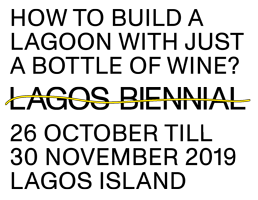Lagos Biennial 2019: How to Build a Lagoon With Just A Bottle of Wine?
Date: 26 October – 23 November 2019
Curators: Tosin Oshinowo, Oyindamola Fakeye & Antawan I. Byrd
The Lagos Biennial aims to place art in dialogue with the city and urban imaginaries. The first edition in 2017 took place at a railway compound in Yaba. This solidified the Biennial’s simultaneous consideration of urbanism and contemporary art. Establishing its own kind of mapping practice with the desire to move the Biennial to different historically and architecturally significant sites in Lagos with each iteration, it builds art-inspired location points.
The site for the 2019 Lagos Biennial, Independence House located on Lagos Island, spoke directly to the intentions of that year’s curators. The 25-story concrete reinforced building was provided as a gift to the Nigerian government by the British in 1959 in honour of independence. At the time of its completion in 1963 it was one of the most prominent buildings in Nigeria, becoming a visual and architectural signifier of ambitions and visions that were put forward after independence.
The history and location of this building was central in influencing the curatorial strategies implemented by the biennial’s curatorial team, Antawan I. Byrd, Tosin Oshinowo and Oyindamola Fakeye. The majority of the works shown at the Biennial were produced in Lagos and were a responsive to the city, drawing on local materials and contexts.
The title for the biennial, How To Build a Lagoon with Just a Bottle of Wine?, was inspired by a line in the poem A Song for Lagos by Nigerian writer Akeem Lasisi. By posing this as a question, the curators were able to encourage the contributing artists to thinking inventively and poetically about urban narratives and imaginaries, and allow them to find direction from the title in their own way. Phrasing the title as a question also invited an open way for audiences to engage with the work.
Continuing with the Biennial’s central focus, the programme OFF-ISH operated as an extension of the Biennial into other parts of the city. This extension showcased how art and curatorial practice can create coordinate points, building an imagined map that draws upon varied urban narratives and imaginaries, as well as understandings of navigation, expression and access. Exhibitions, performances and parties hosted by collectives and other cultural practitioners broadened avenues for thinking about the purpose and methods of display and engagement for a Biennial.
The inaugural Curatorial Intensive took place concurrently with the first week of 2019 edition of the Lagos Biennial. The Intensive facilitators included George Mahashe, Kwasi Ohene-Ayeh, Dana Whabira, Samuel Leuenberger, and Patrick Mudekereza with N’goné Fall as the chief facilitator.


